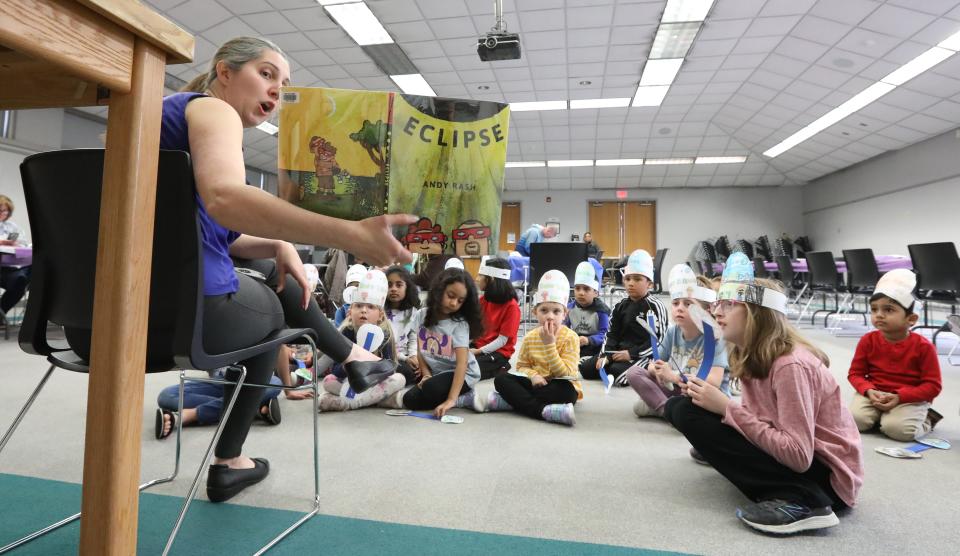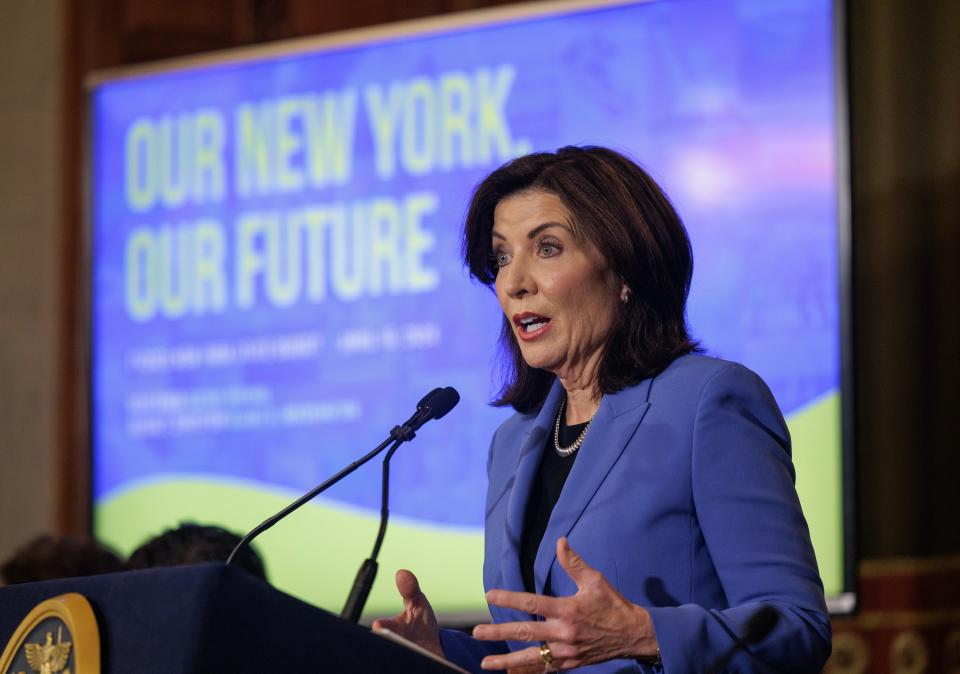NYS developing best practices on early reading instruction and schools will have to comply
- Oops!Something went wrong.Please try again later.
In addition to funding clean energy, gun violence prevention and housing, New York's state budget addresses a top concern in education: students' low reading scores.
Gov. Kathy Hochul pushed for schools to be required to use a phonics-based approach to teach reading, and the state budget directs the state Education Department to produce best practices for teaching reading, grounded in the so-called science of reading, by early 2025. School districts will have to verify annually that they are following the practices in the early grades.
Last school year, only 48% of students in grade 3 though 8 scored as proficient in reading on state testing, a statistic Hochul previously referenced when discussing her plans to address literacy.
Educators and experts have generally agreed with the need for a research-based approach to teaching reading, but some have expressed concern over the state mandating such a policy.

"We did not hear strong objections to this particular proposal, but part of the concern is the precedent or the slippery slope," said Robert Lowry, deputy director for advocacy, research, and communications at the New York State Council of School Superintendents. "Would we see something on math next year or requirements to teach specific subjects or topics?"
The state Education Department's best practices on reading, due Jan. 1, 2025, will largely determine how much school districts might have to alter their reading instruction. Starting in September 2025, districts must annually verify they follow SED's best practices.
It is not yet known how specific the state's best practices might be or how much latitude the state will give districts. It's also unclear how compliance will be determined and enforced.
Asked about concerns over legislating changes to what educators teach, a spokesperson for Hochul said the initiative wasn't a mandate and is "it’s curriculum agnostic." The spokesperson said "school districts can decide what curriculum works best for their students, as long as they abide by the instructional best practices produced by SED."
The budget also includes $10 million train 20,000 students in the forthcoming best practices.
While the state Education Department works on its best practices, and upcoming training for teachers is still being developed, officials shared some details on both.
Training Teachers: NY schools await details on 'science of reading' training for teachers
Best practices, details on compliance, to come
Officials with the state Education Department said this week its best practices will build on a series of briefs it previously released to educators throughout the state.
The briefs, developed by Nonie Lesaux, an education professor at Harvard, outline the science of reading's six major pillars: phonics, vocabulary, comprehension, fluency, oral language (being able to speak and listen), and phonemic awareness (hearing and understanding spoken words). The briefs also covered classroom activities that support the development of the six pillars and how they differ by grade.

The budget says New York's best practices for teaching reading should focus on those concepts.
SED officials said that learning to read isn't achieved through any given curriculum and that curriculum decisions will remain up to school districts.
"We have no intentions of creating a list of approved curriculums," Angelique Johnson-Dingle, deputy state commissioner of P-12 instructional support, said in an interview. "Curriculums need to be based on the local contexts."
The Education Department said it will release a curriculum review guide before the end of June to help guide districts' conversations about their curriculums.
"New York, by law, is a local control state, leaving curriculum decisions to the local school board and district leaders," SED said in an emailed statement. "And this dichotomy exists for a reason: There is no 'one-size-fits-all' approach. Districts are able to create or adopt curricula that meet their specific, local needs."
Officials didn't yet know how school districts will show compliance. Some state directives require school districts to simply fill out forms verifying compliance, while others are more closely reviewed.
Asked what would happen if a district does not want to comply, Education Department officials said they did not yet know. They said they expect widespread compliance and that district officials who don't want to comply would likely face questions from their school boards.
Officials added that compliance will be obvious in districts when student performance improves.
School districts have concerns over autonomy, funding
Marc Baiocco, Clarkstown schools superintendent and president-elect of the Lower Hudson Council of School Superintendents, raised several concerns beyond the state's choice to mandate approaches to instruction.
Baiocco and other Lower Hudson superintendents support a research-based approach to teaching reading but still worry about what could be "one-size-fits-all" approach.
Then there's always the concern over costly state mandates that the state won't pay for. Lowry noted that districts that had changed their reading instruction said it could be expensive to do so.
After a tumultuous budget cycle during which legislators fought off proposed cuts to state "foundation aid," Baiocco wondered what future challenges to state aid to schools could mean for funding new literacy programs. Hochul had proposed dropping a guarantee that school districts get at least the same amount of foundation aid as the year before, but the final budget maintained that precedent.
Baiocco also noted that standardized testing would need to reflect the changes in reading instruction.
Learning to Read: Hochul pushed for phonics. Does 'science of reading' support it?
NYSUT developing training, SUNY training already offered
The state budget earmarked $10 million for New York State United Teachers, the statewide teachers union, to train 20,000 teachers on evidence-based reading instruction.
NYSUT said it has been in communication with SED, the state Division of Budget and the governor's office as it develops the training.
In emailed responses to questions, a NYSUT spokesperson said the goal was for the training to align with the best practices SED will release.
The training will be open to all educators, including administrators, and will be open to private school staff. It will focus on reading instruction for grades pre-K through 3.
The training will be free to participants. Details of how the training will count toward continuing education credits will be finalized in a state-approved plan, NYSUT said.
The budget also gave $1 million each to SUNY and CUNY for teacher "microcredential" programs on the science of reading.
SUNY New Paltz launched a science of reading microcredential for teachers in September last year. College President Darrell Wheeler said the remote program had already reached 6,000 teachers.
Wheeler said the 35-credit program provides teachers with the fundamental concepts of the science of reading — the same pillars outlined in SED's previously released briefs.
Dawn Brooks-DeCosta, deputy superintendent of Community School District 5 in Harlem, took the program in the fall. She said the strategies it provided could be applied under many curriculums.
Brooks-DeCosta pointed to a general lack of training for student teachers on how to teach reading. She said that unless an education student plans on becoming a reading specialist, they won't get enough instruction, or specific enough instruction, on how to teach kids to read.
"It's very basic things, but strangely enough it's not the way we've been teaching reading for so long," Brooks-DeCosta said.
Contact Diana Dombrowski at ddombrowski@gannett.com. Follow her on Twitter at @domdomdiana.
This article originally appeared on Rockland/Westchester Journal News: New York schools phonics plan, science of reading legislated by Hochul

